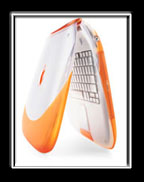










You
know how important they say it is to be a well-rounded person? The iBook was
designedto be a well-rounded notebook computer. Smoothly rounded edges that
fit the curve of your hands, pleasing textures, a brilliant 12.1-inch high-resolution
active-matrix display, and a convenient carrying handle that folds away out
of sight are among the many thoughtful touches you'll appreciate about the
iBook. And with a 56K modem, a 10/100BASE-T Ethernet port, Mac OS 8.6 and
all the right software already installed, it's as Internet-ready as a notebook
computer can be.
The
Beauty and the Beast But while you'll love the way the iBook looks and feels
and connects to the Internet, you'll learn to respect the beast within. Because
the iBook is powered by a blazingly fast 300MHz PowerPC G3 processor-great
for surfing the Internet, whipping out homework assignments, sending and receiving
email, or beating the daylights out of friends at multiplayer games. The iBook
is made for computing on the move: it comes fully-loaded with a lithium-ion
battery that runs up to six houts between charges. The iBook has a tough polycarbonate
body built to withstand life in a backpack-and no doors or latches to break.






Overview
of Problem Studies to define the scope of the Y2K problem and the costs to fix
it have produced widely varying results, causing confusion and concern. The
problem has caught the media's attention and the public's imagination, and it
has stimulated aggressive vendor response. Almost all computer-based systems
will be adversely affected by the arrival of the Year 2000 (01/01/2000), unless
action is taken now to replace, update, or change components of these systems
to eliminate or otherwise mitigate the effects of this event. Fixing and testing
the problem poses a significant problem for system and particularly software
maintenance. For whatever reason-whether they wanted to save precious memory
in an era when memory was incredibly expensive, or because they didníŽt expect
systems to last this long, or because they simply didníŽt recognize the problem-programmers
long ago adopted a two-digit convention to represent the year. This convention
will cause failures as we approach the turn of the century and beyond. The problem
has precedent: Few realized that the IBM 360 could not handle dates past 31
December 1969 until 360s all over Europe started failing at midnight local time.
As the failures progressed around the globe, following the timezones, IBM identified
the problem and was able to provide its American and Asian customers with a
temporary fix by telling them to lie to their computers about the date. Meanwhile,
IBM proceeded to create a longer-term patch for the problem. Unfortunately,
the problem is not isolated to programming errors caused by the use of the two-digit
year coding scheme. The year 2000 presents a "triple witching hour" of potential
traps for designers and coders. In addition to the two-digit year coding, there
are distinct issues surrounding the use of the six-digit date representation,
and still other risks caused by the calculation of the leap year. And just to
make matters worse, January 1, 2000 falls on a Saturday. Problems caused by
coding errors may not be discovered until the next regular working day, allowing
enough time for the errors to inflict a great deal of damage.
NEW
STYLE
NEW
COLOURS
NEW
SHAPE
NEW
MAC iBOOK
- CopyRight
1999 A-Bomb
- All
Right Reserved Unauthorised reproduction





